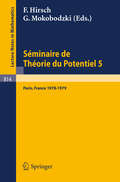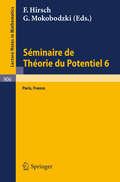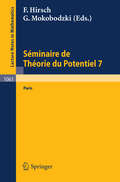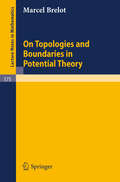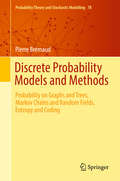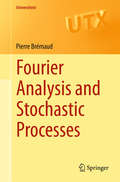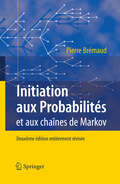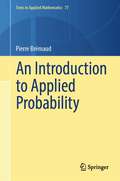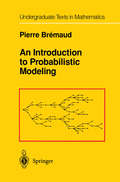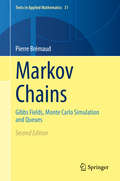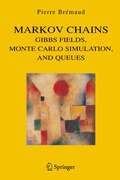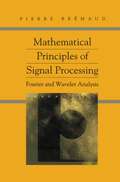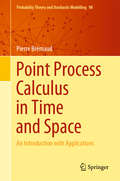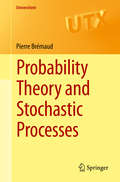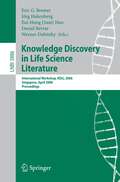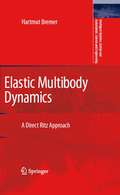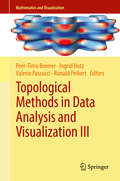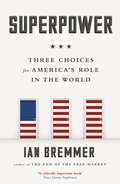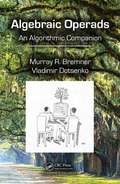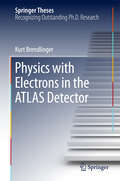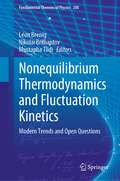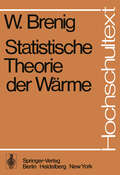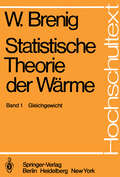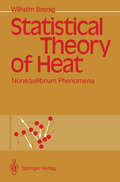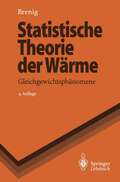- Table View
- List View
Séminaire de Théorie du Potentiel, Paris, 1978-1979, No. 5 (Lecture Notes in Mathematics #814)
by M. Brelot F. Hirsch G. Choquet G. Mokobodzki J. DenySéminaire de Théorie du Potentiel, Paris, No. 6 (Lecture Notes in Mathematics #906)
by M. Brelot F. Hirsch G. Choquet G. Mokobodzki J. DenySminaire de Theorie du Potentiel Paris, No. 7 (Lecture Notes in Mathematics #1061)
by M. Brelot F. Hirsch G. Choquet G. Mokobodzki J. DenyOn Topologies and Boundaries in Potential Theory (Lecture Notes in Mathematics #175)
by Marcel BrelotDiscrete Probability Models and Methods: Probability on Graphs and Trees, Markov Chains and Random Fields, Entropy and Coding (Probability Theory and Stochastic Modelling #78)
by Pierre BrémaudThe emphasis in this book is placed on general models (Markov chains, random fields, random graphs), universal methods (the probabilistic method, the coupling method, the Stein-Chen method, martingale methods, the method of types) and versatile tools (Chernoff's bound, Hoeffding's inequality, Holley's inequality) whose domain of application extends far beyond the present text. Although the examples treated in the book relate to the possible applications, in the communication and computing sciences, in operations research and in physics, this book is in the first instance concerned with theory. The level of the book is that of a beginning graduate course. It is self-contained, the prerequisites consisting merely of basic calculus (series) and basic linear algebra (matrices). The reader is not assumed to be trained in probability since the first chapters give in considerable detail the background necessary to understand the rest of the book.
Fourier Analysis and Stochastic Processes (Universitext)
by Pierre BrémaudThis work is unique as it provides a uniform treatment of the Fourier theories of functions (Fourier transforms and series, z-transforms), finite measures (characteristic functions, convergence in distribution), and stochastic processes (including arma series and point processes).It emphasises the links between these three themes. The chapter on the Fourier theory of point processes and signals structured by point processes is a novel addition to the literature on Fourier analysis of stochastic processes. It also connects the theory with recent lines of research such as biological spike signals and ultrawide-band communications.Although the treatment is mathematically rigorous, the convivial style makes the book accessible to a large audience. In particular, it will be interesting to anyone working in electrical engineering and communications, biology (point process signals) and econometrics (arma models). Each chapter has an exercise section, which makes Fourier Analysis and Stochastic Processes suitable for a graduate course in applied mathematics, as well as for self-study.
Initiation aux Probabilités: et aux chaînes de Markov
by Pierre BrémaudCette introduction aux concepts probabilistes et au calcul des probabilités s'adresse aux élèves-ingénieurs ou aux étudiants qui ne se destinent pas a priori à une carrière en mathématiques. La présentation, bien qu'utilisant le formalisme moderne, ne fait donc pas appel à une connaissance préalable de la Théorie de la Mesure et de l'Intégration. En revanche, l'auteur insiste tout au long du livre sur l'aspect essentiel de la modélisation, à l'aide d'exercises variés en génétique (processus de branchement) en théorie des communicaitons (transmission de données, codage), en théorie du signal (filtre de Kalman-Bucy), en recherche opérationnelle (fils d'attente) en statistique (tests d'hypothèses), etc. Une dernière caractéristique importante de ce livre est la présence d'une centaine d'exercices avec solutions détaillées.
An Introduction to Applied Probability (Texts in Applied Mathematics #77)
by Pierre BrémaudThis book provides the elements of probability and stochastic processes of direct interest to the applied sciences where probabilistic models play an important role, most notably in the information and communications sciences, computer sciences, operations research, and electrical engineering, but also in fields like epidemiology, biology, ecology, physics, and the earth sciences.The theoretical tools are presented gradually, not deterring the readers with a wall of technicalities before they have the opportunity to understand their relevance in simple situations. In particular, the use of the so-called modern integration theory (the Lebesgue integral) is postponed until the fifth chapter, where it is reviewed in sufficient detail for a rigorous treatment of the topics of interest in the various domains of application listed above.The treatment, while mathematical, maintains a balance between depth and accessibility that is suitable for theefficient manipulation, based on solid theoretical foundations, of the four most important and ubiquitous categories of probabilistic models:Markov chains, which are omnipresent and versatile models in applied probabilityPoisson processes (on the line and in space), occurring in a range of applications from ecology to queuing and mobile communications networksBrownian motion, which models fluctuations in the stock market and the "white noise" of physicsWide-sense stationary processes, of special importance in signal analysis and design, as well as in the earth sciences.This book can be used as a text in various ways and at different levels of study. Essentially, it provides the material for a two-semester graduate course on probability and stochastic processes in a department of applied mathematics or for students in departments where stochastic models play an essential role. The progressive introduction of concepts and tools, along with the inclusion of numerous examples, also makes this book well-adapted for self-study.
An Introduction to Probabilistic Modeling (Undergraduate Texts in Mathematics)
by Pierre BremaudIntroduction to the basic concepts of probability theory: independence, expectation, convergence in law and almost-sure convergence. Short expositions of more advanced topics such as Markov Chains, Stochastic Processes, Bayesian Decision Theory and Information Theory.
Markov Chains: Gibbs Fields, Monte Carlo Simulation and Queues (Texts in Applied Mathematics #31)
by Pierre BrémaudPrimarily an introduction to the theory of stochastic processes at the undergraduate or beginning graduate level, the primary objective of this book is to initiate students in the art of stochastic modelling. However it is motivated by significant applications and progressively brings the student to the borders of contemporary research. Examples are from a wide range of domains, including operations research and electrical engineering. Researchers and students in these areas as well as in physics, biology and the social sciences will find this book of interest.
Markov Chains: Gibbs Fields, Monte Carlo Simulation, and Queues (Texts in Applied Mathematics #31)
by Pierre BremaudPrimarily an introduction to the theory of stochastic processes at the undergraduate or beginning graduate level, the primary objective of this book is to initiate students in the art of stochastic modelling. However it is motivated by significant applications and progressively brings the student to the borders of contemporary research. Examples are from a wide range of domains, including operations research and electrical engineering. Researchers and students in these areas as well as in physics, biology and the social sciences will find this book of interest.
Mathematical Principles of Signal Processing: Fourier and Wavelet Analysis
by Pierre BremaudFrom the reviews: "[…] the interested reader will find in Bremaud’s book an invaluable reference because of its coverage, scope and style, as well as of the unified treatment it offers of (signal processing oriented) Fourier and wavelet basics." Mathematical Reviews
Point Process Calculus in Time and Space: An Introduction with Applications (Probability Theory and Stochastic Modelling #98)
by Pierre BrémaudThis book provides an introduction to the theory and applications of point processes, both in time and in space. Presenting the two components of point process calculus, the martingale calculus and the Palm calculus, it aims to develop the computational skills needed for the study of stochastic models involving point processes, providing enough of the general theory for the reader to reach a technical level sufficient for most applications. Classical and not-so-classical models are examined in detail, including Poisson–Cox, renewal, cluster and branching (Kerstan–Hawkes) point processes.The applications covered in this text (queueing, information theory, stochastic geometry and signal analysis) have been chosen not only for their intrinsic interest but also because they illustrate the theory. Written in a rigorous but not overly abstract style, the book will be accessible to earnest beginners with a basic training in probability but will also interest upper graduate students and experienced researchers.
Probability Theory and Stochastic Processes (Universitext)
by Pierre BrémaudThe ultimate objective of this book is to present a panoramic view of the main stochastic processes which have an impact on applications, with complete proofs and exercises. Random processes play a central role in the applied sciences, including operations research, insurance, finance, biology, physics, computer and communications networks, and signal processing.In order to help the reader to reach a level of technical autonomy sufficient to understand the presented models, this book includes a reasonable dose of probability theory. On the other hand, the study of stochastic processes gives an opportunity to apply the main theoretical results of probability theory beyond classroom examples and in a non-trivial manner that makes this discipline look more attractive to the applications-oriented student. One can distinguish three parts of this book. The first four chapters are about probability theory, Chapters 5 to 8 concern random sequences, or discrete-time stochastic processes, and the rest of the book focuses on stochastic processes and point processes. There is sufficient modularity for the instructor or the self-teaching reader to design a course or a study program adapted to her/his specific needs. This book is in a large measure self-contained.
Knowledge Discovery in Life Science Literature: International Workshop, KDLL 2006, Singapore, April 9, 2006, Proceedings (Lecture Notes in Computer Science #3886)
by Eric G. Bremer Jörg Hakenberg Eui-Hong Sam Han Daniel Berrar Werner DubitzkyThis book constitutes the refereed proceedings of the International Workshop on Knowledge Discovery in Life Science Literature, KDLL 2006, held in conjunction with the 10th Pacific-Asia Conference on Knowledge Discovery and Data Mining (PAKDD 2006). The 12 revised full papers presented together with two invited talks were carefully reviewed and selected for inclusion in the book. The papers cover all topics of knowledge discovery in life science data.
Elastic Multibody Dynamics: A Direct Ritz Approach (Intelligent Systems, Control and Automation: Science and Engineering #35)
by Hartmut Bremer1. Background This textbook is an introduction to and exploration of a number of core topics in the ?eld of applied mechanics. Mechanics, in both its theoretical and applied contexts, is, like all scienti?c endeavors, a human construct. It re?ects the personalities, thoughts, errors, and successes of its creators. We therefore provide some personal information about each of these individuals when their names arise for the ?rst time in this book. This should enable the reader to piece together a cultural-historical picture of the ?eld s origins and development. This does not mean that we are writing history. Nevertheless, some remarks putting individuals and ideas in context are necessary in order to make clear what we are speaking about – and what we are not speaking about. At the end of the 19th century, technical universities were established eve- where in Europe in an almost euphoric manner. But the practice of technical mechanics itself, as one of the basics of technical development, was in a desolate state, due largely to the refusal of its practitioners to recognize the in?uence of kinetics on motion. They were correct to the extend that then current mechanical systems moved with small velocities where kinetics does not play a signi?cant role. But they had failed to keep up with developments in the science underlying their craft and were unable to keep pace with the speeds of such systems as the steam engine.
Topological Methods in Data Analysis and Visualization III: Theory, Algorithms, and Applications (Mathematics and Visualization)
by Peer-Timo Bremer Ingrid Hotz Valerio Pascucci Ronald PeikertThis collection of peer-reviewed conference papers provides comprehensive coverage of cutting-edge research in topological approaches to data analysis and visualization. It encompasses the full range of new algorithms and insights, including fast homology computation, comparative analysis of simplification techniques, and key applications in materials and medical science. The volume also features material on core research challenges such as the representation of large and complex datasets and integrating numerical methods with robust combinatorial algorithms.Reflecting the focus of the TopoInVis 2013 conference, the contributions evince the progress currently being made on finding experimental solutions to open problems in the sector. They provide an inclusive snapshot of state-of-the-art research that enables researchers to keep abreast of the latest developments and provides a foundation for future progress. With papers by some of the world’s leading experts in topological techniques, this volume is a major contribution to the literature in a field of growing importance with applications in disciplines that range from engineering to medicine.
Superpower: Three Choices for America’s Role in the World
by Ian BremmerGeopolitical thought leader Ian Bremmer issues a clarion call to America: redefine your place in the world, or the world will define it for youAmerica's identity abroad has long been defined by the second World War and years of Cold War struggle. But the new America has changed; its role and identity are in flux - and with them, the global balance of power.In Three Choices for a Superpower, president and founder of the Eurasia Group, Ian Bremmer, calls for a completely new definition of America as a superpower - one that adheres to distinct priorities and values. He outlines the three choices facing the new America:Be independent: America does not have an endless supply of blood and finances to spend on other nations. Rather, America will fare much better if it devotes its energies and resources to rebuilding strength from within. Moneyball: America cannot afford every foreign fight in support of American values, but they must defend their interests wherever they are threatened. They must make tough decisions intelligently, with an open admission of America's limitations.Be indispensable: To think that America can operate autonomously from the rest of the world is not only ignorant but also extremely dangerous. The world relies on American leadership, and America has international interests - they must continue their role as an indispensable nation and remain actively involved abroad.As the 2016 presidential election approaches, America needs to define its responsibilities, opportunities, and most importantly, its limits. A foreign policy divided against itself cannot stand; as the world's greatest superpower, America must choose which path it will follow into the future.
Algebraic Operads: An Algorithmic Companion
by Murray R. Bremner Vladimir DotsenkoAlgebraic Operads: An Algorithmic Companion presents a systematic treatment of Grobner bases in several contexts. The book builds up to the theory of Grobner bases for operads due to the second author and Khoroshkin as well as various applications of the corresponding diamond lemmas in algebra. The authors present a variety of topics including: non
Physics with Electrons in the ATLAS Detector (Springer Theses)
by Kurt BrendlingerThis thesis presents two production cross-section measurements of pairs of massive bosons using final states with leptons, made with the ATLAS detector at the Large Hadron Collider. The first measurement, performed using data collected in 2012 at center-of-mass energy √ s = 8 TeV, is the first fiducial and differential cross-section measurement of the production of the Higgs Boson when it decays to four charged leptons (electrons or muons). The second measurement is the first fiducial and inclusive production cross-section measurement of WZ pairs at center-of-mass energy √ s = 13 TeV using final states with three charged leptons. A significant portion of the thesis focuses on the methods used to identify electrons from massive boson decay—important for many flagship measurements—and on assessing the efficiency of these particle identification techniques. The chapter discussing the WZ pair cross-section measurement provides a detailed example of an estimate of lepton background in the context of an analysis with three leptons in the final state.
Nonequilibrium Thermodynamics and Fluctuation Kinetics: Modern Trends and Open Questions (Fundamental Theories of Physics #208)
by Léon Brenig Nikolai Brilliantov Mustapha TlidiThis book addresses research challenges in the rapidly developing area of nonequilibrium thermodynamics and fluctuation kinetics. This cross-disciplinary field comprises various topics, ranging from fundamental problems of nonequilibrium statistical mechanics and thermodynamics to multiple applications in plasma, fluid mechanics, nonlinear science, systems of dissipative particles, and high-Q resonators. The purpose of this book is to bring together world-leading experts in the above fields to initiate a cross-fertilization among these active research areas. The book is dedicated to and honours the memory of Professor Slava Belyi who passed away unexpectedly on May 20, 2020. He was pioneering the theory of nonequilibrium fluctuations, in particular the application of the Callen-Welton fluctuation-dissipation theorem to nonequilibrium systems and its generalization. This and related problems also feature in the book.
Statistical Theory of Heat: Nonequilibrium Phenomena
by Wilhelm BrenigThis text on the statistical theory of nonequilibrium phenomena grew out of lecture notes for courses on advanced statistical mechanics that were held more or less regularly at the Physics Department of the Technical University in Munich. My aim in these lectures was to incorporate various developments of many-body theory made during the last 20-30 years, in particular the correlation function approach, not just as an "extra" alongside the more "classical" results; I tried to use this approach as a unifying concept for the presentation of older as well as more recent results. I think that after so many excellent review articles and advanced treatments, correlation functions and memory kernels are as much a matter of course in nonequilibrium statistical physics as partition functions are in equilibrium theory, and should be used as such in regular courses and textbooks. The relations between correlation functions and earlier vehicles for the formulation of nonequilibrium theory such as kinetic equations, master equations, Onsager's theory, etc. , are discussed in detail in this volume. Since today there is growing interest in nonlinear phenomena I have included several chapters on related problems. There is some nonlinear response theory, some results on phenomenological nonlinear equations and some microscopic applications of the nonlinear response formalism. The main focus, however, is on the linear regime.
Statistische Theorie der Wärme: Gleichgewichtsphänomene (Springer-Lehrbuch)
by Wilhelm BrenigDie vierte Auflage der Statistischen Theorie der Wärme wurde gründlich überarbeitet und durch zahlreiche durchgerechnete Beispiele ergänzt. Die Gleichgewichtsphänomene werden in drei Teilen behandelt: I. Statistische Gesamtheiten und das thermische Gleichgewicht, II. Gleichgewichtsthermodynamik, III. Berechnung thermodynamischer Funktionen. Die einzelnen Kapitel sind übersichtlich aufgebaut und ermöglichen es dem Leser, sich schnell zu informieren. Studierende der Physik, der chemischen Physik und bis zu einem gewissen Grade auch der Chemie und Technik finden hier eine grundlegende Einführung. Der Anwendungsteil macht das Lehrbuch zudem auch für Wissenschaftler interessant. Dieses Standardwerk wird auch noch lange nach der Vorlesung wertvolle Dienste beim Nachschlagen leisten und als Fundgrube für Querverbindungen und Methoden dienen.
